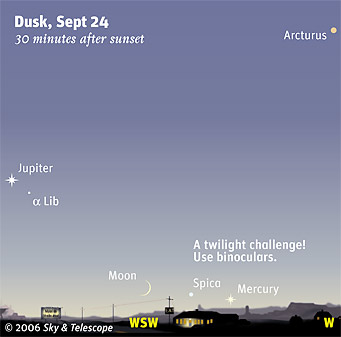
Use binoculars or other optical aid to look for the thin Moon, Spica, and Mercury very low in bright twilight on Sunday the 24th. These scenes are drawn for the middle of North America. Europeans will find the Moon closer to Spica than drawn here. For clarity, the Moon is shown three times actual size.
Dave Tytell
Shortly after sunset on Sunday the 24th (25th for observers in East Asia), you may be able to catch the ever-elusive Mercury in an unusual lineup with Spica and a thin crescent Moon. But it won't be easy — you'll need binoculars, an unobstructed western horizon, and very clear air. And the farther south you are, the better. Mercury will be just two degrees above the horizon at 40° north, the latitude of New York, and nearly twice that in Los Angeles, at 34°. The event should be relatively easy to see in the Southern Hemisphere, where the three objects will be lined up vertically above the setting Sun.
Note where the Sun sets, and 15 minutes later, start scanning the horizon 10° to 15° south of that point. It will be a tight race. Every few minutes, the sky will get visibly darker and Mercury will get significantly lower. Good luck! And please report any successful sightings to [email protected].
While you're there, don't forget to take a look at Jupiter, well off to the south. It's nearing the end of its apparition in the evening sky. How many of its moons can you spot through binoculars?
Remember to use SkyandTelescope.com's various Interactive Observing Tools such as our Jovian moon tracker and Red Spot finder to make the most of your observing session.
 0
0
Comments
You must be logged in to post a comment.